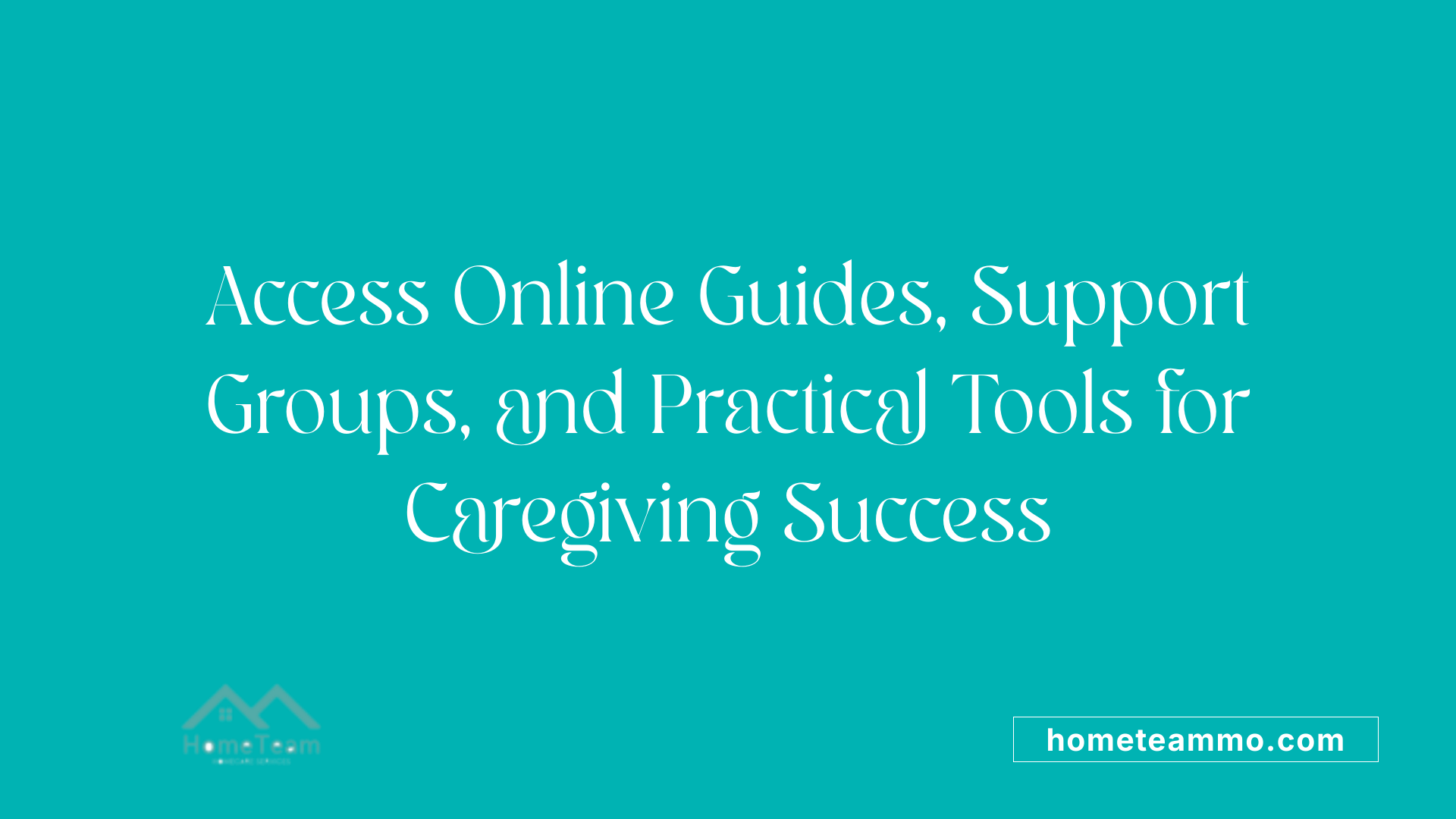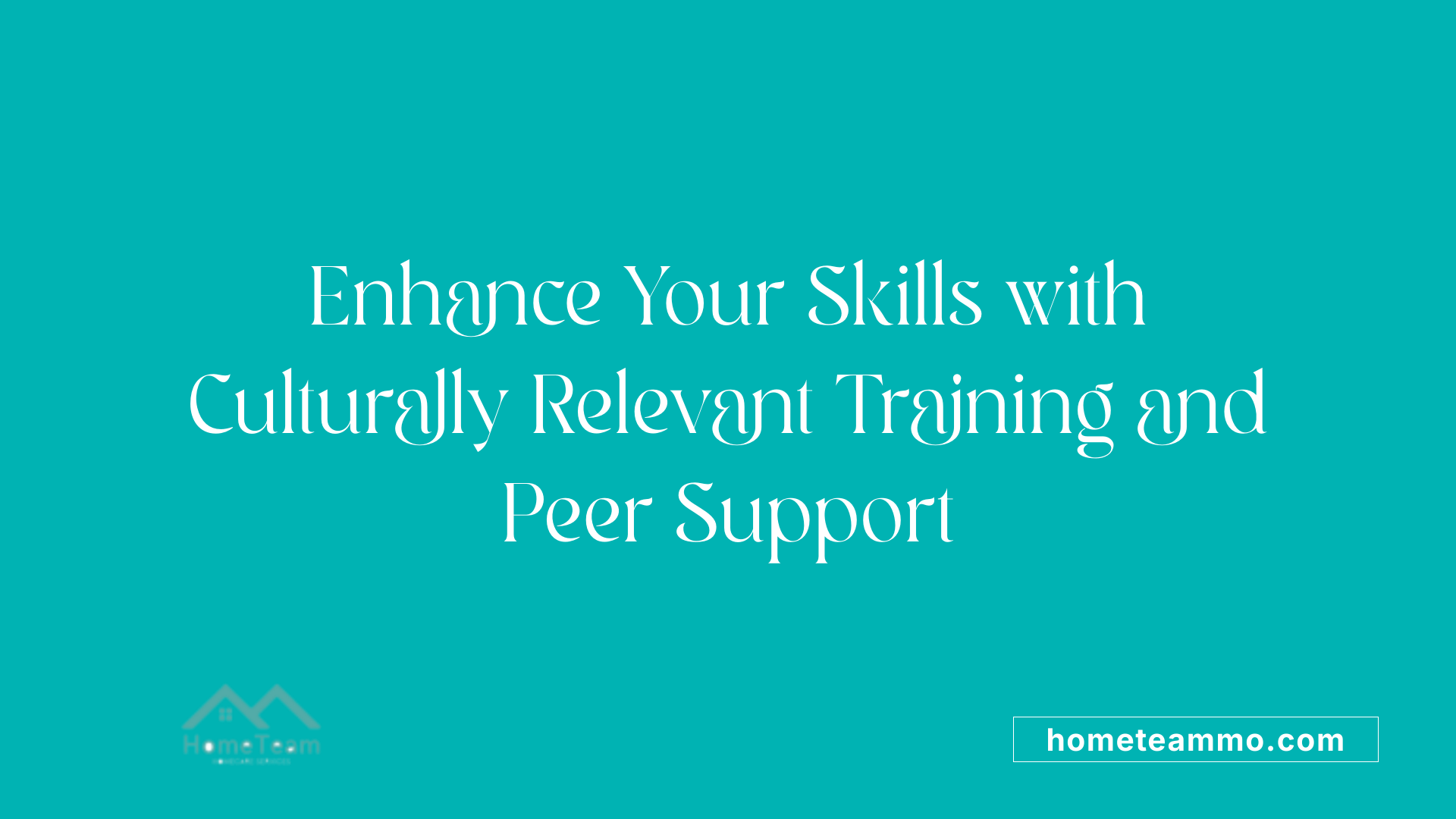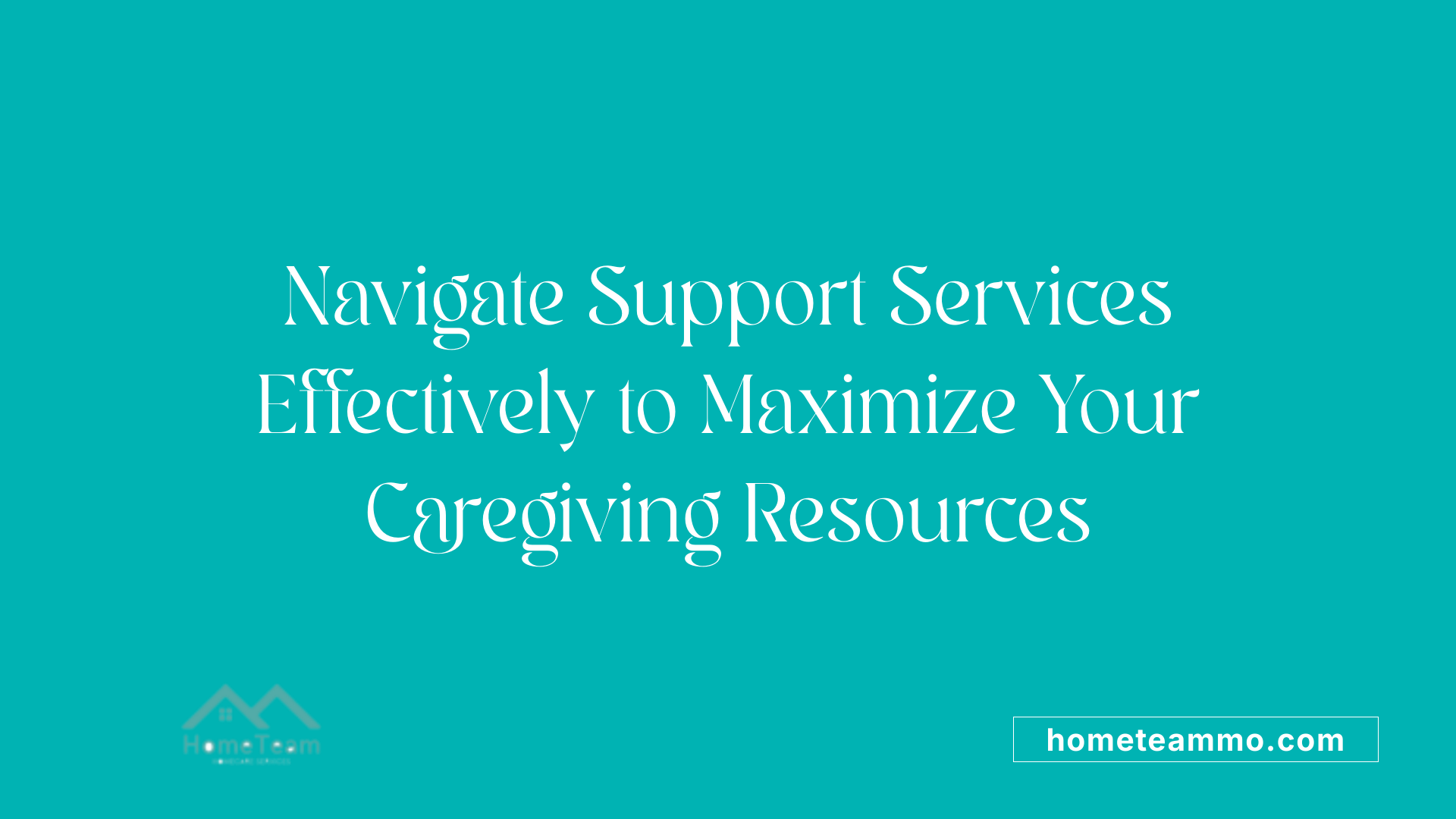How Home Team Supports Caregivers with Training and Resources
Empowering Caregivers for Better Outcomes

Enhancing Support Through Training and Resources
Effective caregiving is fundamental to maintaining the health and well-being of older adults and individuals with disabilities. Recognizing the vital role caregivers play, numerous home, community, and national organizations have developed comprehensive training programs and resource networks designed to boost caregiver confidence, improve care quality, and promote caregiver well-being. This article explores how the 'home team'—comprising government agencies, nonprofit organizations, and support networks—supports caregivers through tailored training, accessible educational materials, and strategic initiatives.
Diverse Educational Materials and Support Resources for Caregivers
 Caregivers have access to a wide variety of educational materials and support resources designed to enhance their caregiving skills and well-being. These resources include comprehensive handbooks, informational websites, instructional videos, webinars, support groups, and training programs offered by government agencies, nonprofit organizations, and community groups.
Caregivers have access to a wide variety of educational materials and support resources designed to enhance their caregiving skills and well-being. These resources include comprehensive handbooks, informational websites, instructional videos, webinars, support groups, and training programs offered by government agencies, nonprofit organizations, and community groups.
One prominent source is the National Institute on Aging (NIA), which provides a rich collection of caregiving resources. Caregivers can find articles focused on health management, safety tips, legal planning, medication management, and preparing for long-term care. Many of these materials are available as downloadable infographics, PDFs, or online guides.
Organizations like AARP and the Caregiver Action Network also offer free guides, toolkits, and online classes that cover essential caregiving topics. These materials are often available in multiple languages to serve diverse communities. The support services extend beyond printed or digital materials, including access to support networks, online forums, and local support groups, which foster a sense of community and shared experience.
Many educational programs incorporate practical tools such as checklists for daily care tasks, safety assessments, and legal document templates. Webinars and virtual training sessions are particularly helpful for caregivers balancing other responsibilities, providing flexible options to learn best practices.
Overall, these resources aim to empower caregivers by offering practical advice, emotional support, and strategies for effective caregiving. Their goal is to help caregivers succeed in their roles while safeguarding their own health and well-being.
Training Programs That Foster Confidence and Competence
Many caregiver training programs are designed to improve both the skills and confidence of those providing care. These courses often cover essential topics like stress management, problem-solving, effective communication, and dementia care strategies. When caregivers participate in such training, they are better equipped to handle daily challenges, which leads to safer and higher-quality care for their loved ones.
Programs like Powerful Tools for Caregivers, Building Better Caregivers, and VA caregiver initiatives offer structured learning opportunities. For example, Powerful Tools for Caregivers is a six-week online or in-person workshop proven to reduce stress and improve caregivers’ self-care behaviors. Building Better Caregivers provides a similar six-week online course that also focuses on relaxing techniques and managing difficult behaviors.
VA programs such as Caregivers FIRST and REACH VA offer group training and coaching services. These programs help caregivers learn how to communicate effectively with health providers, manage safety concerns, and navigate complex health systems.
Participating in these programs benefits caregivers by increasing their confidence and problem-solving abilities. It also enhances care quality, supports emotional health, and fosters stronger relationships with care recipients. As caregivers become more skilled and self-assured, they can better address the evolving needs of those they support.
| Program Name | Duration | Focus Areas | Delivery Method |
|---|---|---|---|
| Powerful Tools for Caregivers | 6 weeks | Stress reduction, self-care, problem-solving | In-person and virtual |
| Building Better Caregivers | 6 weeks | Self-management, stress, difficult behaviors | Online |
| VA Caregivers FIRST | 4 sessions | Emotional management, communication, legal issues | In-person or virtual |
| REACH VA | Variable | Safety, self-care, veteran support | Coaching, group sessions |
These educational opportunities underscore the importance of ongoing learning in caregiving. Accessing such programs can make a significant difference in how caregivers support their loved ones and maintain their well-being.
Strategic Support Initiatives by Home and Community Support Teams
How do home and community support teams identify and assist caregivers?
Support teams use multiple strategies to find and help caregivers effectively. They often embed identification processes within state agencies and other public systems to catch caregivers early. Outreach efforts extend to partnerships with private organizations, local employers, and community groups to reach diverse populations and address cultural differences.
Public awareness campaigns and distribution of caregiver resource packets help inform families about available supports. Education for stakeholders about caregiver needs encourages more people to recognize their role and seek assistance. These efforts promote a proactive approach to caregiver identification and support.
How are data collection and care planning personalized?
Central to effective caregiving support is understanding individual caregiver needs. Support teams employ assessment tools and gather data through surveys, interviews, and health records. This information helps create tailored care plans, ensuring caregivers receive targeted services suited to their specific situations. Such personalized plans encompass education, peer support, respite services, and practical training.
Using data-driven approaches allows teams to monitor caregiver progress, adapt interventions as needed, and better allocate resources, ultimately fostering stronger support networks.
What programs focus on education, support, and training?
Various programs address different caregiver needs:
- Educational Initiatives: These include caregiver workshops, online courses like Building Better Caregivers (BBC), and the Annie Caregiver Text Program, which offers ongoing messages for managing stress.
- Peer and Support Groups: Connecting caregivers through groups organized by organizations such as the Family Caregiver Alliance or local community centers fosters shared experiences and emotional support.
- Respite Care Services: Respite programs, including private in-home care or adult day services, provide caregivers brief breaks to prevent burnout.
- Targeted Training: Programs like Caregivers FIRST offer clinical skills, while VA’s Caregiver Support Program provides specific training on activities such as bathing, transferring, and medication management.
These initiatives collectively enhance caregiver confidence, reduce stress, and improve overall care quality.
Below is a summary table that encapsulates various support strategies:
| Support Focus | Examples of Programs and Activities | Intended Outcome |
|---|---|---|
| Identification & Outreach | Public campaigns, partnerships, resource packets | Early detection and service engagement |
| Data & Care Planning | Assessment tools, personalized plans | Tailored support, efficient resource use |
| Education & Training | Workshops, online programs, text messages | Skill development, confidence building |
| Peer Support & Groups | Support networks, community groups | Emotional support, shared experiences |
| Respite & Relief | In-home respite, adult day centers | Burnout prevention, caregiver well-being |
These comprehensive efforts aim to strengthen caregiver capacity and enhance community support systems, ensuring caregivers are better equipped and more supported in their vital roles.
Community and Virtual Training Opportunities for Diverse Caregivers

What community-based and virtual training programs are available for caregivers?
There is a wide array of training options accessible to caregivers across different settings. Many programs are offered in local community centers, senior centers, and through organizations like Area Agencies on Aging. These include structured workshops, skills training, and peer support groups.
In addition to in-person offerings, many programs have developed virtual formats. Online modules, webinars, live virtual classes, and telehealth support are increasingly available, making training accessible regardless of geographical or physical barriers.
Examples include VA’s Caregivers FIRST, which offers four-session group trainings in person or via virtual platforms, and the Annie Caregiver Text Program providing ongoing motivational messages online. Respite providers such as Synapticure also incorporate remote education and resource coordination to support caregivers.
What types of programs, including workshops, online modules, and support groups, are available?
Caregiver support stretches across various formats:
- Workshops: Short-term, interactive sessions focusing on stress management, safety, and health system navigation.
- Online Modules: Self-paced courses on dementia care, legal planning, or behavioral management.
- Support Groups: Both in-person and virtual peer groups, such as those facilitated by the National Alliance on Caregiving and AARP.
- Educational Text Programs and Coaching: Programs like the Annie Caregiver Text and REACH VA that combine technology and personal coaching.
These diverse options allow caregivers to select formats aligned with their schedules, learning preferences, and cultural needs.
How do these programs ensure cultural relevance and accessibility?
Recognizing the diversity of caregiving populations, many programs tailor content to different cultural backgrounds and languages. For instance, Riverside County’s Care Pathways workshops are offered both in English and Spanish. Virtual programs often include accommodations such as subtitles, translation services, and flexible scheduling.
Organizations like the South Dakota Department of Human Services emphasize person-centered approaches that respect individual cultural values and community norms.
Overall, the availability of community-based and virtual training expands access, supports inclusivity, and helps ensure that caregivers from various backgrounds can benefit and improve their caregiving skills.
| Program Type | Format | Focus Areas | Accessibility Features |
|---|---|---|---|
| Workshops | In-person, Virtual | Stress reduction, safety, health system navigation | Multilingual options, flexible timing |
| Online Modules | Self-paced | Dementia, legal planning, behaviors | Language options, easy digital access |
| Support Groups | In-person, Virtual | Peer support, shared experiences | Regional availability, online participation |
| Educational Texts and Coaching | Mobile, Email | Stress management, coping skills | Text messaging, online platforms |
Navigating Resources and Maximizing Support Services

How can caregivers effectively navigate and utilize support services?
Caregivers often face a complex array of resources designed to help them in their vital role. To maximize these benefits, it's crucial to begin with a clear understanding of personal and care recipient needs. This helps in selecting the most appropriate services.
A good starting point is to explore trusted directories and online resources. Government sites like Health.gov, and organizations such as AARP or the Caregiver Action Network, provide comprehensive listings of local and national programs. Local Area Agencies on Aging and Eldercare Locator are valuable for finding nearby services, including respite care, support groups, and educational workshops.
Evaluating resources involves checking credibility, accreditation, and reviews. Contacting local agencies or programs directly can give insight into available services, whether it’s home care, transportation assistance, or caregiver training classes.
Recognizing signs of burnout — such as persistent stress, exhaustion, or emotional fatigue — is vital. Seeking emotional support through peer groups, counseling, or therapy can help caregivers cope with emotional burdens.
Staying informed about financial aid options, legal resources, and advocacy opportunities also empowers caregivers. This comprehensive approach allows them to manage responsibilities more effectively, ensuring both their well-being and their loved ones' care.
Supporting Caregivers for Better Health and Care
Through a combination of comprehensive training programs, accessible educational materials, strategic community and virtual initiatives, and strategic navigation of available support services, home teams and organizations are playing a pivotal role in empowering caregivers. These efforts not only improve the quality of care provided but also significantly enhance caregivers’ well-being, resilience, and confidence. As awareness and access continue to grow, caregivers can better sustain their vital roles, ensuring healthier outcomes for the individuals they serve.
References
- Powerful Tools For Caregivers: Home
- GUIDE Part 4: Supporting Caregivers with Respite, Education and ...
- Program of General Caregiver Support Services (PGCSS)
- The Caring for Caregivers Program: Practical Approaches for ...
- Family Caregiver Support Program / Care Giving Resources
- Caregiving Resources & Links for Support - CaringInfo
- Caregiver Resource Centers - DHCS - CA.gov
- Family Caregiver Support - Riverside County Office on Aging
- Caregiver / Family Member
- Training Resources For Caregivers - Maryland Department of ...

Dusting and Vacuuming: Keeping the Home Allergen-Free

Why Local CDS Providers Are Vital for Community Support

How In-Home Care Services Help Seniors with Speech Impairments

The Importance of Regular Health Monitoring in In-Home Care

The impact of ABA therapy on family dynamics

